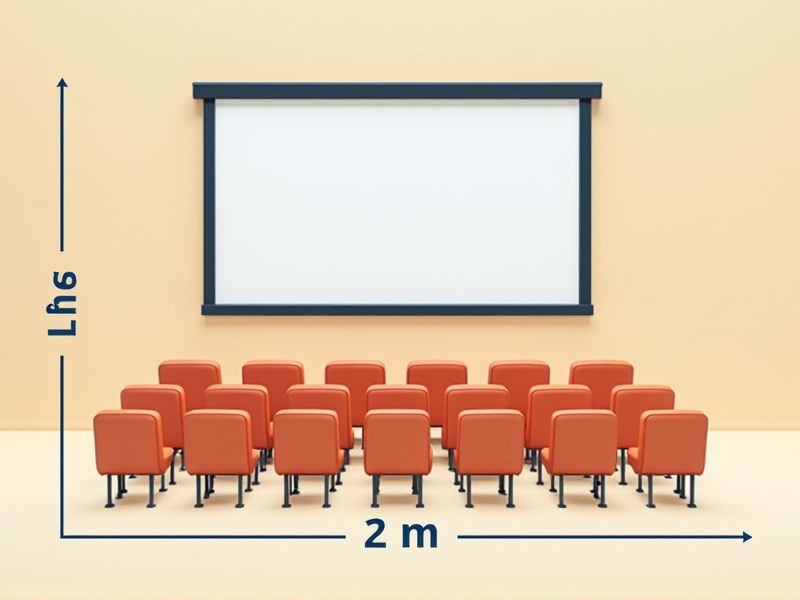
When designing or evaluating a lecture hall, knowing the standard dimensions can help ensure the space is comfortable and functional. Typically, a lecture hall seats anywhere from 100 to 300 people, with each seat requiring roughly 20 to 24 inches of width and about 36 inches depth for legroom and passage. The overall dimensions often range from 60 to 100 feet in width and 80 to 120 feet in length, depending on capacity and layout. Ensuring clear sightlines, good acoustics, and accessible pathways in these dimensions enhances the learning experience for all attendees.
Seating Capacity
The standard seating capacity for a lecture hall typically ranges from 100 to 500 seats, accommodating various teaching formats and audience sizes. Lecture halls designed for larger groups often feature tiered seating, enhancing visibility and engagement for every participant. It is crucial to consider the optimal arrangement of desks and chairs to promote comfort and accessibility, balancing aesthetics with functionality. When planning your lecture hall, ensure that the layout meets fire safety regulations and provides adequate access for all attendees.
Aisle Width
Aisle width in a lecture hall typically ranges between 3 to 4 feet, ensuring accessibility and safe movement for students and staff. Wider aisles, around 5 feet, facilitate better traffic flow, particularly during peak class transitions. Compliance with safety regulations often mandates specific dimensions based on occupancy; for example, a hall with 100 seats may require at least two aisles for optimal egress. Ensuring adequate aisle width enhances the overall learning environment by promoting quick access to exits and reducing congestion.
Stage Height
The ideal stage height in lecture halls typically ranges from 12 to 24 inches to ensure visibility for all attendees. A stage elevation of 18 inches is often recommended for optimal sightlines, allowing individuals seated at the back to have an unobstructed view. Proper stage height not only enhances audience engagement but also facilitates effective communication between the speaker and the audience. For your lecture hall design, consider incorporating adjustable stage options to accommodate varying needs and preferences.
Audio-Visual Equipment
A standard lecture hall typically includes advanced audio-visual equipment such as high-definition projectors, surround sound speakers, and integrated video conferencing systems, which enhance the learning experience. These facilities often accommodate up to 150 students, ensuring that each individual can engage effectively with the presented material. Interactive whiteboards and touchscreen displays can support real-time student participation, elevating discussion and collaboration. Furthermore, optimal acoustics and ergonomic seating arrangements are essential features, contributing to both comfort and effective communication within the space.
Lighting Design
The lighting design of a standard lecture hall typically incorporates a color temperature range between 3000K and 4000K, creating a warm yet conducive environment for learning. Effective illumination levels are generally maintained at 300 to 500 lux to ensure visual comfort without causing eye strain. Incorporating smart lighting controls can enhance energy efficiency by allowing you to adjust brightness based on occupancy and time of day. In addition, using dimmable LED fixtures not only reduces energy consumption by up to 75% but also provides flexibility in adapting the lighting for different presentation needs.
Acoustics
Lecture halls must prioritize acoustics to create an optimal learning environment, with ideal sound levels typically ranging from 60 to 70 decibels for clear communication. The design often incorporates materials like acoustic panels and carpeting that absorb sound and reduce echo, improving speech intelligibility. A well-designed lecture hall can improve student engagement and retention rates by as much as 20%, enhancing overall educational outcomes. Implementing state-of-the-art sound systems can also ensure that every student, regardless of where they sit, can hear the lecture clearly without straining.
Hvac System
A well-designed HVAC (Heating, Ventilation, and Air Conditioning) system is crucial for maintaining optimal air quality and thermal comfort in lecture halls, typically accommodating between 50 to 500 students. An effective HVAC system must achieve a temperature range between 68degF and 72degF (20degC to 22degC) while ensuring air exchanges of 15 to 20 per hour, which promotes a conducive learning environment. Advanced filtration systems are essential in removing pollutants and allergens, significantly reducing the risk of respiratory issues for occupants. Regular maintenance, including filter replacements and system inspections, is necessary to uphold performance efficiency and indoor air quality.
Accessibility Features
A standard lecture hall prioritizes accessibility features to ensure inclusivity for all students. This includes wheelchair-accessible seating and pathways, with at least one designated area that can accommodate wheelchairs. Hearing assistance technology, such as induction loops or FM systems, is typically provided, benefiting students with hearing impairments. Furthermore, clear signage and visual aids enhance the learning environment for individuals with visual impairments, promoting a more equitable educational experience.
Writing Surfaces
Writing surfaces in lecture halls significantly influence student engagement and learning outcomes. High-quality surfaces, such as whiteboards or chalkboards, should ideally measure at least 6 feet in width to accommodate various teaching styles and group sizes. Using non-glare materials can enhance visibility and reduce eye strain, ensuring maximum attention during lectures. You may also consider that incorporating interactive elements, like writable walls, can foster collaboration and creativity among students.
Entrance And Exit Doors
A well-designed lecture hall typically features two main types of doors: entrance and exit, each adhering to specific building codes for safety and accessibility. Entrance doors often have a width of at least 32 inches, allowing for easy access for all students, including those with disabilities. Exit doors, which should ideally be placed at opposite ends of the hall, provide safe egress in case of emergencies and must open outward to facilitate a quick evacuation. Ensuring these doors are equipped with appropriate signage and automatic openers can greatly enhance the overall safety and convenience for attendees.
